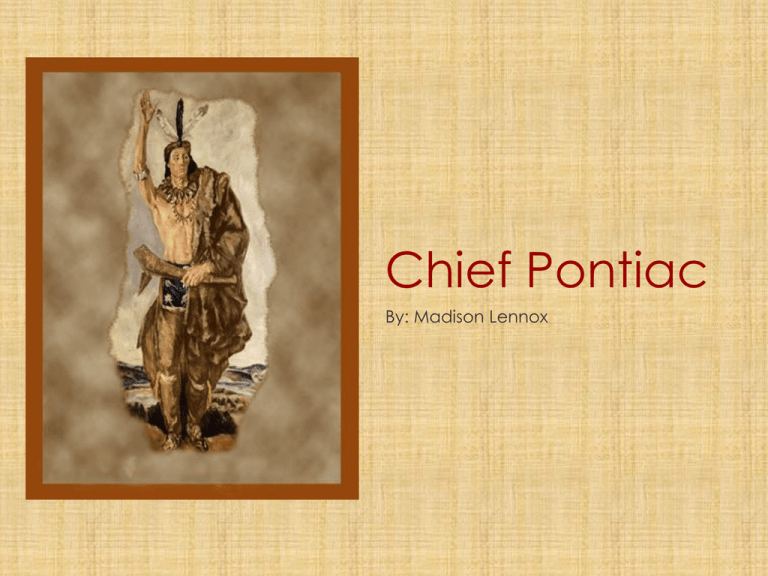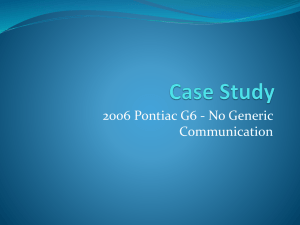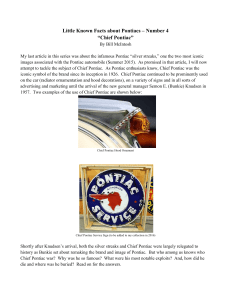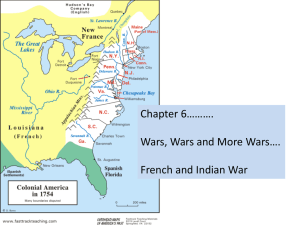Chief Pontiac: Life, Rebellion, and Legacy
advertisement

Chief Pontiac By: Madison Lennox Chief Pontiac’s Early Life Chief Pontiac was born in an Ottawa Village in 1720. His mother was an Ojibwa and his father was an Ottawa. He was known Obwandiyag in his village. He was an Ottawa war leader by 1747. He was assassinated by a Peoria Indian on April 20th,1769. Pontiac’s Rebellion Chief Pontiac continued to support the French throughout The French and Indian War. Pontiac’s Rebellion began in May 1763, after the British won the war and occupied the Great Lakes Region. Pontiac and 300 followers attempted to take Fort Detroit by surprise. This plan eventually foiled but, 2,000 British people, 450 British soldiers and 200 Native American Warriors were killed or captured in the process. Native Americans involved in the capture of Fort Detroit, included Ottawa, Ojibwas, Potawatomis and Hurons. Chief Pontiac’s message reached tribes across the land. Pontiac’s Rebellion The Ottawa Tribe Ottawa, spelled Odawa in their native language, means “traders”. The Ottawa and the Ojibwa and Potawatomi tribes are related, they have mostly identical cultures and languages. Most Ottawas lived/live in Ontario, Michigan and Oklahoma. The Ottawa tribes did lots of story-telling, artwork and music, and traditional medicine. The people lived in villages of birch bark houses called wigwams. Examples of Wigwams The Council of Three Fires The Ottawa and Ojibwa tribes were apart of a long term alliance with the Potawatomi tribe. This was called the Council of Three Fires. They fought the Iroquois Confederacy and the Sioux. In this council, the Ojibwa were addressed as the “older brother”, Ottawa, “middle brother” and Potawatomi, “younger brother”. Hero vs. Villain Some people think that Pontiac was a hero because he occupied the North American Great Lakes Region. He also negotiated with the British to get the Native Americans out of a punishment for the war. Some people considered him a villain because he never accomplished his original goal, which was to expell the British from their homeland. Pontiac, MI and Pontiac, IL Pontiac, Michigan was named after Chief Pontiac because he had made the area his headquarters for his Ottawa Tribe. Pontiac, Illinois was named after Chief Pontiac because after his plan failed to take over Fort Detroit, he came to Illinois Country to resist more British occupation. Relationship between the French The French traders and the Native American tribes had always had good relations with one another. They traded furs for supplies, like food, guns, ammunition, and tobacco. Because of this good relationship, the Native Americans sided against Britain, with the French, in The French and Indian War. After Pontiac’s Rebellion After Pontiac’s Rebellion, by 1764, the French had no longer supported the Native American efforts or beliefs so, they actually sided with the British. By July 1766 Pontiac agreed to sign a peace treaty at Fort de Chartres, Illinois. Three years later he was killed by a Peoria Indian, and for revenge, the Ottawa Indians later attacked and killed many Peoria Indians. Peoria Indian Moccasins Bibliography http://www.chiefpontiac.org/ http://en.wikipedia.org/wiki/Chief_Pontiac http://en.wikipedia.org/wiki/File:Pontiac%27s_war.png http://www.enchantedlearning.com/explorers/page/p/pontiac.shtml http://www.detroithistorical.org/main/pdfs/ChiefPontiac.pdf http://www.ohiojudicialcenter.gov/pontiac.asp http://www.tolatsga.org/otta.html http://www.bigorrin.org/ottawa_kids.htm Book- Pontiac: Ottawa Rebel, By: Celia Bland, published in 1995, Genre- Biography The End! I really enjoyed working on this project. Chief Pontiac was very interesting to learn about. My favorite thing was learning all about the Ottawa tribe and the other Native American tribes that were associated with them. I hope you liked learning about Chief Pontiac as much as I did! Thanks for reading!











